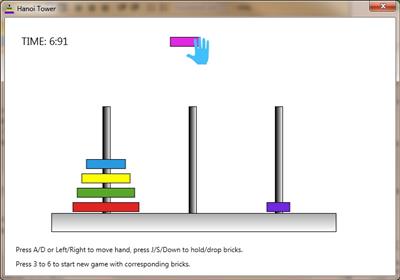

Grafman et al., 1992 evaluated the performance of 12 patients with cerebellar atrophy using the 5 disks Tower of Hanoi task. However, performance on the 4 disks Tower of Hanoi task was slightly better than in the 3 disks version in schizophrenic patients suggesting the ability to acquire a procedure and greater preservation of basal ganglia function. In comparison to the control group, schizophrenic patients performed significantly worse. Goldberg et al., 1990 used 3 and 4 disks versions of the Tower of Hanoi to assess learning and problem-solving capabilities in schizophrenic patients.

A significant performance difference was found between the two groups, with the high emotional intelligence group making lesser errors and requiring lesser time for the task. The study employed a four disks version of the task without the constraint “no larger disk should be placed on a smaller disk.” The subjects were also not given any time constraints. In comparison to healthy controls, a significant difference in performance was observed.Īrefnasab et al., 2012 compared the problem-solving capabilities of individuals with high emotional intelligence with those having low emotional intelligence.

The executive function assessment was performed using 3 and 4 disks Tower of Hanoi. Yang et al., 2017 assessed the often-neglected neurocognitive functioning in cancer patients with PTSD. The patients showed extreme difficulty in completing the task and showed significantly poorer performance as the disk numbers were increased. The task was carried out using a varying number of disks (2 to 5 disks). 24 patients with mild Alzheimer’s were assessed for their planning capabilities. Balances, Scales and Weighing Equipmentīalachandar et al., 2015 evaluated the age-related cognitive decline using the Tower of Hanoi task.Their disks are then returned to the respective starting positions. If the participant makes an incorrect move at any point then they are prompted with a Feedback Display that states this. The experiment displays visual stimuli which is updated with each move the participant makes while it keeps the finished positions visible. With these rules in mind, the participant is prompted with how many moves are required to successfully end up in the displayed finished positions. Additionally, disks of a smaller size are not allowed to be placed under disks that are larger. However, the disks are only able to be moved one at a time. To goal of the experiment is to transfer the disks from their starting rod positions to the position(s) needed to satisfy the finished setup displayed at the top of the screen. This paradigm consists of three rods and a minimum of three disks of different sizes. This experiment illustrates the use of multiple InLine scripts to create a variety of Tower of Hanoi scenarios. This is a mouse-driven version of the classic Tower of Hanoi task in which the subject is supposed to find the fastest solution (in terms of number of moves) from a given initial state.

The Tower of Hanoi is a mathematical puzzle that tests executive functioning in participants. Adapted from STEP and used with permission of Brian MacWhinney Groot, FPP-ITM (Vrije Universiteit Amsterdam).


 0 kommentar(er)
0 kommentar(er)
